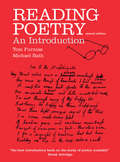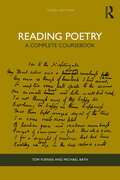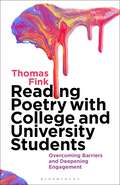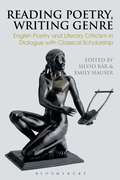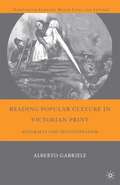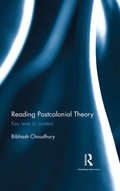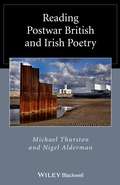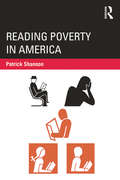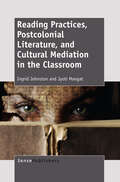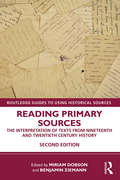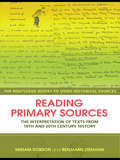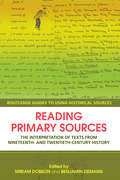- Table View
- List View
Reading Poetry: An Introduction
by Tom Furniss Michael BathReading Poetry offers a comprehensive and accessible guide to the art of reading poetry. Successive chapters introduce key skills and critical or theoretical issues, enabling users to read poetry with enjoyment, insight and an awareness of the implications of what they are doing. This new edition includes a new chapter on ‘Post-colonial Poetry’, a substantial increase in the number of end-of-chapter interactive exercises, and a comprehensive Glossary of poetic terms. Not just an add-on, the Glossary works as a key resource for the structuring of particular topics in any individual teaching or learning programme. Many of the exercises and interactive discussions develop not only the skills of competent close reading but also the necessary confidence and experience in locating historical and other contextual information through library or internet searches. The aim is to enhance readers' literary and scholarly competence – and to make it fun!
Reading Poetry: A Complete Coursebook
by Tom Furniss Michael BathReading Poetry offers a comprehensive and accessible guide to the art of reading poetry. Discussing more than 200 poems by more than 100 writers, ranging from ancient Greece and China to the twenty-first century, the book introduces readers to the skills and the critical and theoretical awareness that enable them to read poetry with enjoyment and insight. This third edition has been significantly updated in response to current developments in poetry and poetic criticism, and includes many new examples and exercises, new chapters on ‘world poetry’ and ‘eco-poetry’, and a greater emphasis throughout on American poetry, including the impact traditional Chinese poetry has had on modern American poetry. The seventeen carefully staged chapters constitute a complete apprenticeship in reading poetry, leading readers from specific features of form and figurative language to larger concerns with genre, intertextuality, Caribbean poetry, world poetry, and the role poetry can play in response to the ecological crisis. The workshop exercises at the end of each chapter, together with an extensive glossary of poetic and critical terms, and the number and range of poems analysed and discussed – 122 of which are quoted in full – make Reading Poetry suitable for individual study or as a comprehensive, self-contained textbook for university and college classes.
Reading Poetry: A Complete Coursebook
by Tom Furniss Michael BathReading Poetry offers a comprehensive and accessible guide to the art of reading poetry. Discussing more than 200 poems by more than 100 writers, ranging from ancient Greece and China to the twenty-first century, the book introduces readers to the skills and the critical and theoretical awareness that enable them to read poetry with enjoyment and insight. This third edition has been significantly updated in response to current developments in poetry and poetic criticism, and includes many new examples and exercises, new chapters on ‘world poetry’ and ‘eco-poetry’, and a greater emphasis throughout on American poetry, including the impact traditional Chinese poetry has had on modern American poetry. The seventeen carefully staged chapters constitute a complete apprenticeship in reading poetry, leading readers from specific features of form and figurative language to larger concerns with genre, intertextuality, Caribbean poetry, world poetry, and the role poetry can play in response to the ecological crisis. The workshop exercises at the end of each chapter, together with an extensive glossary of poetic and critical terms, and the number and range of poems analysed and discussed – 122 of which are quoted in full – make Reading Poetry suitable for individual study or as a comprehensive, self-contained textbook for university and college classes.
Reading poetry (PDF)
by Peter BarryWitty, direct and articulate, Peter Barry illustrates the key elements of poetry at work, covering many different kinds of verse, from traditional forms to innovative versions of the art, such as ‘concrete’ poetry, minimalism and word-free poems. The emphasis is on meanings rather than words, looking beyond technical devices like alliteration and assonance so that poems are understood as dynamic structures creating specific ends and effects. The three sections cover progressively expanding areas – ‘Reading the lines’ deals with such basics as imagery, diction and metre; ‘Reading between the lines’ concerns broader matters, such as poetry and context, and the reading of sequences of poems, while ‘Reading beyond the lines’ looks at ‘theorised’ readings and the ‘textual genesis’ of poems from manuscript to print. Reading poetry is for students, lecturers and teachers looking for new ways of discussing poetry, and all those seriously interested in poetry, whether as readers or writers.
Reading Poetry with College and University Students: Overcoming Barriers and Deepening Engagement
by Thomas FinkReading Poetry with College and University Students aims to help faculty foster students' intellectual and aesthetic engagement with poems while enabling them to sharpen critical and creative thinking skills. Reading authors across history and the globe--such as Julia Alvarez, Amiri Baraka, Gwendolyn Brooks, Mahmoud Darwish, John Donne, Paolo Javier, Yusef Komunyakaa, Audre Lorde, and Wislawa Szymborska--Thomas Fink zeroes in on how learners can surmount and even enjoy tackling the most difficult aspects of poetry. By exploring students' emotional identification with speakers and characters of poems as well as poets themselves, Fink shows how an instructor can motivate students to produce effective and empathic interpretations. Through divergent readings of selected poems, the book addresses the influence of various theoretical paradigms, ranging from ecological, psychological, feminist, and queer theory to deconstructive, postcolonial, and surface reading orientations. Instructors receive practical guidance through these poems, poets, and modes of reading, helping to give learners raw material to reach their own nuanced interpretations and strengthen their emotional, aesthetic, and intellectual acumen.
Reading Poetry with College and University Students: Overcoming Barriers and Deepening Engagement
by Thomas FinkReading Poetry with College and University Students aims to help faculty foster students' intellectual and aesthetic engagement with poems while enabling them to sharpen critical and creative thinking skills. Reading authors across history and the globe--such as Julia Alvarez, Amiri Baraka, Gwendolyn Brooks, Mahmoud Darwish, John Donne, Paolo Javier, Yusef Komunyakaa, Audre Lorde, and Wislawa Szymborska--Thomas Fink zeroes in on how learners can surmount and even enjoy tackling the most difficult aspects of poetry. By exploring students' emotional identification with speakers and characters of poems as well as poets themselves, Fink shows how an instructor can motivate students to produce effective and empathic interpretations. Through divergent readings of selected poems, the book addresses the influence of various theoretical paradigms, ranging from ecological, psychological, feminist, and queer theory to deconstructive, postcolonial, and surface reading orientations. Instructors receive practical guidance through these poems, poets, and modes of reading, helping to give learners raw material to reach their own nuanced interpretations and strengthen their emotional, aesthetic, and intellectual acumen.
Reading Poetry, Writing Genre: English Poetry and Literary Criticism in Dialogue with Classical Scholarship (Bloomsbury Studies in Classical Reception)
by Silvio Bär Emily HauserThis ground-breaking volume connects the situatedness of genre in English poetry with developments in classical scholarship, exploring how an emphasis on the interaction between English literary criticism and Classics changes, sharpens, or perhaps even obstructs views on genre in English poetry. “Genre” has classical roots: both in the etymology of the word and in the history of genre criticism, which begins with Aristotle. In a similar vein, recent developments in genre studies have suggested that literary genres are not given or fixed entities, but subjective and unstable (as well as historically situated), and that the reception of genre by both writers and scholars feeds back into the way genre is articulated in specific literary works.Classical scholarship, literary criticism, and genre form a triangle of key concepts for the volume, approached in different ways and with different productive results by contributors from across the disciplines of Classics and English literature. Covering topics from the establishment of genre in the Middle Ages to the invention of female epic and the epyllion, and bringing together the works of English poets from Milton to Tennyson to Josephine Balmer, the essays collected hereargue that the reception and criticism of classical texts play a crucial part in generic formation in English poetry.
Reading Poetry, Writing Genre: English Poetry and Literary Criticism in Dialogue with Classical Scholarship (Bloomsbury Studies in Classical Reception)
by Silvio Bär Emily HauserThis ground-breaking volume connects the situatedness of genre in English poetry with developments in classical scholarship, exploring how an emphasis on the interaction between English literary criticism and Classics changes, sharpens, or perhaps even obstructs views on genre in English poetry. “Genre” has classical roots: both in the etymology of the word and in the history of genre criticism, which begins with Aristotle. In a similar vein, recent developments in genre studies have suggested that literary genres are not given or fixed entities, but subjective and unstable (as well as historically situated), and that the reception of genre by both writers and scholars feeds back into the way genre is articulated in specific literary works.Classical scholarship, literary criticism, and genre form a triangle of key concepts for the volume, approached in different ways and with different productive results by contributors from across the disciplines of Classics and English literature. Covering topics from the establishment of genre in the Middle Ages to the invention of female epic and the epyllion, and bringing together the works of English poets from Milton to Tennyson to Josephine Balmer, the essays collected hereargue that the reception and criticism of classical texts play a crucial part in generic formation in English poetry.
Reading Popular Culture in Victorian Print: Belgravia and Sensationalism (Nineteenth-Century Major Lives and Letters)
by A. GabrieleReading Popular Culture in Victorian Print: Belgravia and Sensationalism is a comprehensive study of the whole run of the monthly periodical Belgravia under the direction of Mary Elizabeth Braddon. It traces the material history of the magazine, its production and global distribution while at the same time placing its history and content in the context of Victorian popular culture and Victorian discursive formations. Among the questions Reading Popular Culture in Victorian Print investigates are the status of authors in the marketplace, the innovative place Belgravia holds in the history of print culture, the rhetoric of sensationalism in fiction, journalism and pre-cinema, the representation of trade with India, and the use of urban space as a branding strategy. It makes the claim that the periodical is the sensation novel of the 1860s.
Reading Postcolonial Theory: Key texts in context
by Bibhash ChoudhuryThis book is an essential introduction to significant texts in postcolonial theory. It looks at seminal works in the ‘moments of their making’ and delineates the different threads that bind postcolonial studies. Each chapter presents a comprehensive discussion of a major text and contextualises it in the wake of contemporary themes and debates. The volume: Studies major texts by foremost scholars — Edward W. Said, Chinua Achebe, Albert Memmi, Gayatri Chakravorty Spivak, Paul Carter, Homi Bhabha, Frantz Fanon, Ashis Nandy, Robert J. C. Young, Ngugi wa Thiongo, and Sara Suleri Shifts focus from colonial experience to underlying principles of critical engagement Uses accessible, jargon-free language Focused, engaging and critically insightful, this book will be indispensable to students and scholars of literary and cultural studies, comparative literature, and postcolonial studies.
Reading Postcolonial Theory: Key texts in context
by Bibhash ChoudhuryThis book is an essential introduction to significant texts in postcolonial theory. It looks at seminal works in the ‘moments of their making’ and delineates the different threads that bind postcolonial studies. Each chapter presents a comprehensive discussion of a major text and contextualises it in the wake of contemporary themes and debates. The volume: Studies major texts by foremost scholars — Edward W. Said, Chinua Achebe, Albert Memmi, Gayatri Chakravorty Spivak, Paul Carter, Homi Bhabha, Frantz Fanon, Ashis Nandy, Robert J. C. Young, Ngugi wa Thiongo, and Sara Suleri Shifts focus from colonial experience to underlying principles of critical engagement Uses accessible, jargon-free language Focused, engaging and critically insightful, this book will be indispensable to students and scholars of literary and cultural studies, comparative literature, and postcolonial studies.
Reading Postwar British and Irish Poetry (Wiley Blackwell Reading Poetry #16)
by Michael Thurston Nigel AldermanCombining detailed explorations of both mainstream and experimental poets with a clear historical and literary overview, Reading Postwar British and Irish Poetry offers readers at all levels an ideal guide to the rich body of poetic works published in Britain and Ireland over the last half-century. Features detailed discussions of individual poems that are widely available in anthologies and selected poems volumes Pays explicit attention to how to read the poems, focusing on language and form and the institutional conditions of literary possibility in which poets worked Includes poets of all types and styles from throughout the post-war period, including canonical and mainstream poets alongside experimental poets, women, and poets of color
Reading Postwar British and Irish Poetry (Wiley Blackwell Reading Poetry #15)
by Michael Thurston Nigel AldermanCombining detailed explorations of both mainstream and experimental poets with a clear historical and literary overview, Reading Postwar British and Irish Poetry offers readers at all levels an ideal guide to the rich body of poetic works published in Britain and Ireland over the last half-century. Features detailed discussions of individual poems that are widely available in anthologies and selected poems volumes Pays explicit attention to how to read the poems, focusing on language and form and the institutional conditions of literary possibility in which poets worked Includes poets of all types and styles from throughout the post-war period, including canonical and mainstream poets alongside experimental poets, women, and poets of color
Reading Poverty in America
by Patrick ShannonIn this book Shannon’s major premise remains the same as his 1998 Reading Poverty: Poverty has everything to do with American public schooling–how it is theorized, how it is organized, and how it runs. Competing ideological representations of poverty underlie school assumptions about intelligence, character, textbook content, lesson formats, national standards, standardized achievement tests, and business/school partnerships and frame our considerations of each. In this new edition, Shannon provides an update of the ideological struggles to name and respond to poverty through the design, content, and pedagogy of reading education, showing how, through their representations and framing, advocates of liberal, conservative, and neoliberal interpretations attempt the ideological practice of teaching the public who they are, what they should know, and what they should value about equality, civic society, and reading. For those who decline these offers, Shannon presents radical democratic interpretations of the relationship between poverty and reading education that position the poor, the public, students, and teachers as agents in redistribution of economic, cultural, and political capital in the United States.
Reading Poverty in America
by Patrick ShannonIn this book Shannon’s major premise remains the same as his 1998 Reading Poverty: Poverty has everything to do with American public schooling–how it is theorized, how it is organized, and how it runs. Competing ideological representations of poverty underlie school assumptions about intelligence, character, textbook content, lesson formats, national standards, standardized achievement tests, and business/school partnerships and frame our considerations of each. In this new edition, Shannon provides an update of the ideological struggles to name and respond to poverty through the design, content, and pedagogy of reading education, showing how, through their representations and framing, advocates of liberal, conservative, and neoliberal interpretations attempt the ideological practice of teaching the public who they are, what they should know, and what they should value about equality, civic society, and reading. For those who decline these offers, Shannon presents radical democratic interpretations of the relationship between poverty and reading education that position the poor, the public, students, and teachers as agents in redistribution of economic, cultural, and political capital in the United States.
Reading Practice: The Pursuit of Natural Knowledge from Manuscript to Print
by Melissa ReynoldsThrough portraits of readers and their responses to texts, Reading Practice reconstructs the contours of the knowledge economy that shaped medicine and science in early modern England. Reading Practice tells the story of how ordinary people grew comfortable learning from commonplace manuscripts and printed books, such as almanacs, medical recipe collections, and herbals. From the turn of the fifteenth century to the close of the sixteenth century, these were the books English people read when they wanted to attend to their health or understand their place in the universe. Before then, these works had largely been the purview of those who could read Latin. Around 1400, however, medical and scientific texts became available in Middle English while manuscripts became less expensive. These vernacular manuscripts invited their readers into a very old and learned conversation: Hippocrates and Galen weren’t distant authorities whose word was law, they were trusted guides, whose advice could be excerpted, rearranged, recombined, and even altered to suit a manuscript compiler’s needs. This conversation continued even after the printing press arrived in England in 1476. Printers mined manuscripts for medical and scientific texts that they would publish throughout the sixteenth century, though the pressures of a commercial printing market encouraged printers to package these old texts in new ways. Without the weight of authority conditioning their reactions and responses to very old knowledge, and with so many editions of practical books to choose from, English readers grew into confident critics and purveyors of natural knowledge in their own right. Melissa Reynolds reconstructs shifting attitudes toward medicine and science over two centuries of seismic change within English culture, attending especially to the effects of the Reformation on attitudes toward nature and the human body. Her study shows how readers learned to be discerning and selective consumers of knowledge gradually, through everyday interactions with utilitarian books.
Reading Practice: The Pursuit of Natural Knowledge from Manuscript to Print
by Melissa ReynoldsThrough portraits of readers and their responses to texts, Reading Practice reconstructs the contours of the knowledge economy that shaped medicine and science in early modern England. Reading Practice tells the story of how ordinary people grew comfortable learning from commonplace manuscripts and printed books, such as almanacs, medical recipe collections, and herbals. From the turn of the fifteenth century to the close of the sixteenth century, these were the books English people read when they wanted to attend to their health or understand their place in the universe. Before then, these works had largely been the purview of those who could read Latin. Around 1400, however, medical and scientific texts became available in Middle English while manuscripts became less expensive. These vernacular manuscripts invited their readers into a very old and learned conversation: Hippocrates and Galen weren’t distant authorities whose word was law, they were trusted guides, whose advice could be excerpted, rearranged, recombined, and even altered to suit a manuscript compiler’s needs. This conversation continued even after the printing press arrived in England in 1476. Printers mined manuscripts for medical and scientific texts that they would publish throughout the sixteenth century, though the pressures of a commercial printing market encouraged printers to package these old texts in new ways. Without the weight of authority conditioning their reactions and responses to very old knowledge, and with so many editions of practical books to choose from, English readers grew into confident critics and purveyors of natural knowledge in their own right. Melissa Reynolds reconstructs shifting attitudes toward medicine and science over two centuries of seismic change within English culture, attending especially to the effects of the Reformation on attitudes toward nature and the human body. Her study shows how readers learned to be discerning and selective consumers of knowledge gradually, through everyday interactions with utilitarian books.
Reading Practices, Postcolonial Literature, and Cultural Mediation in the Classroom
by Ingrid Johnston Jyoti MangatIn this book, Johnston and Mangat consider ways in which particular postcolonial and multicultural literary texts are able to provide a space of cultural mediation for readers from various backgrounds. The studies described in the five chapters of the book explore the spaces of convergence of identity, culture and literature with students and teachers in high school contexts and undergraduates in university settings. In each study, readers are responding to texts that are culturally distant from their own literary and experiential histories. An objective of each study was to consider the nature of the cultural locations of the reader and the text, and the interstitial spaces between these locations. The book interrogates readers’ attempts to negotiate cultural difference in literary contexts and questions how this negotiation requires reading practices traditionally ignored in North American classrooms. The book will offer educators at the secondary and post-secondary levels rich material to draw upon for a rethinking of the school curriculum and will be of interest to scholars of postcolonial and literary studies.
Reading Primary Sources: The Interpretation of Texts from Nineteenth and Twentieth Century History (Routledge Guides to Using Historical Sources)
by Miriam DobsonNow in its second edition, Reading Primary Sources explores the varied traditions in source criticism and, through specific examples, illustrates how primary sources can be read and used in historical research. Part I of this two-part volume begins by establishing the reader’s understanding of source criticism with an overview of both traditional and new methodological approaches to the use of primary documents. Taking into account the huge expansion in the range of primary sources used by historians, Part II includes chapters on surveillance reports, testimony and court files, in addition to more traditional genres such as letters, memoranda, diaries, novels, newspapers, political speeches and autobiography. For the new edition, each chapter now includes a checklist that suggests an easy-to-follow sequence of steps for interpreting a specific source genre, enabling students to understand how the sources should be read, what they have to offer, and the pitfalls of their interpretation. In addition to new discussions about the availability of digitised source materials, a new chapter on social surveys unlocks the potential of these widely used primary sources. Taking examples of sources from many European countries and the United States, and providing up-to-date information on the most widely used textual sources, this book is the perfect companion for every student of history who wants to engage with primary sources.
Reading Primary Sources: The Interpretation Of Texts From 19th And 20th Century History (PDF)
by Miriam Dobson Benjamin ZiemannHow does the historian approach primary sources? How do interpretations differ? How can they be used to write history? Reading Primary Sourcesgoes a long way to providing answers for these questions. In the first part of this unique volume, the chapters give an overview of both traditional and new methodological approaches to the use of sources, analyzing the way that these have changed over time. The second part gives an overview of twelve different types of written sources, including letters, opinion polls, surveillance reports, diaries, novels, newspapers, and dreams, taking into account the huge expansion in the range of written primary sources used by historians over the last thirty years. This book is an up-to-date introduction into the historical context of these different genres, the ways they should be read, the possible insights and results these sources offer and the pitfalls of their interpretation. All of the chapters push the reader beyond a conventional understanding of source texts as mere "reflections" of a given reality, instead fostering an understanding of how each of the various genres has to be seen as a medium in its own right. Taking examples of sources from around the globe, and also including a student-friendly further reading section, this is the perfect companion for every student of history who wants to engage with sources.
Reading Primary Sources: The Interpretation Of Texts From 19th And 20th Century History
by Miriam Dobson Benjamin ZiemannHow does the historian approach primary sources? How do interpretations differ? How can they be used to write history? Reading Primary Sourcesgoes a long way to providing answers for these questions. In the first part of this unique volume, the chapters give an overview of both traditional and new methodological approaches to the use of sources, analyzing the way that these have changed over time. The second part gives an overview of twelve different types of written sources, including letters, opinion polls, surveillance reports, diaries, novels, newspapers, and dreams, taking into account the huge expansion in the range of written primary sources used by historians over the last thirty years. This book is an up-to-date introduction into the historical context of these different genres, the ways they should be read, the possible insights and results these sources offer and the pitfalls of their interpretation. All of the chapters push the reader beyond a conventional understanding of source texts as mere "reflections" of a given reality, instead fostering an understanding of how each of the various genres has to be seen as a medium in its own right. Taking examples of sources from around the globe, and also including a student-friendly further reading section, this is the perfect companion for every student of history who wants to engage with sources.
Reading Primary Sources: The Interpretation of Texts from Nineteenth and Twentieth Century History (Routledge Guides to Using Historical Sources)
by Miriam Dobson Benjamin ZiemannHow does the historian approach primary sources? How do interpretations differ? How can they be used to write history? Reading Primary Sources goes a long way to providing answers for these questions. In the first part of this unique volume, the chapters give an overview of both traditional and new methodological approaches to the use of sources, analyzing the way that these have changed over time. The second part gives an overview of twelve different types of written sources, including letters, opinion polls, surveillance reports, diaries, novels, newspapers, and dreams, taking into account the huge expansion in the range of written primary sources used by historians over the last thirty years. This book is an up-to-date introduction into the historical context of these different genres, the ways they should be read, the possible insights and results these sources offer and the pitfalls of their interpretation. All of the chapters push the reader beyond a conventional understanding of source texts as mere "reflections" of a given reality, instead fostering an understanding of how each of the various genres has to be seen as a medium in its own right. Taking examples of sources from around the globe, and also including a student-friendly further reading section, this is the perfect companion for every student of history who wants to engage with sources.
Reading Primary Sources: The Interpretation of Texts from Nineteenth and Twentieth Century History (Routledge Guides to Using Historical Sources)
by Miriam Dobson Benjamin ZiemannNow in its second edition, Reading Primary Sources explores the varied traditions in source criticism and, through specific examples, illustrates how primary sources can be read and used in historical research. Part I of this two-part volume begins by establishing the reader’s understanding of source criticism with an overview of both traditional and new methodological approaches to the use of primary documents. Taking into account the huge expansion in the range of primary sources used by historians, Part II includes chapters on surveillance reports, testimony and court files, in addition to more traditional genres such as letters, memoranda, diaries, novels, newspapers, political speeches and autobiography. For the new edition, each chapter now includes a checklist that suggests an easy-to-follow sequence of steps for interpreting a specific source genre, enabling students to understand how the sources should be read, what they have to offer, and the pitfalls of their interpretation. In addition to new discussions about the availability of digitised source materials, a new chapter on social surveys unlocks the potential of these widely used primary sources. Taking examples of sources from many European countries and the United States, and providing up-to-date information on the most widely used textual sources, this book is the perfect companion for every student of history who wants to engage with primary sources.
Reading Primary Sources: The Interpretation of Texts from Nineteenth and Twentieth Century History (Routledge Guides to Using Historical Sources)
by Benjamin Ziemann Miriam DobsonHow does the historian approach primary sources? How do interpretations differ? How can they be used to write history? Reading Primary Sources goes a long way to providing answers for these questions. In the first part of this unique volume, the chapters give an overview of both traditional and new methodological approaches to the use of sources, analyzing the way that these have changed over time. The second part gives an overview of twelve different types of written sources, including letters, opinion polls, surveillance reports, diaries, novels, newspapers, and dreams, taking into account the huge expansion in the range of written primary sources used by historians over the last thirty years. This book is an up-to-date introduction into the historical context of these different genres, the ways they should be read, the possible insights and results these sources offer and the pitfalls of their interpretation. All of the chapters push the reader beyond a conventional understanding of source texts as mere "reflections" of a given reality, instead fostering an understanding of how each of the various genres has to be seen as a medium in its own right. Taking examples of sources from around the globe, and also including a student-friendly further reading section, this is the perfect companion for every student of history who wants to engage with sources.
Reading Public Romanticism
by Paul MagnusonReading Public Romanticism is a significant new example of the linking of esthetics and historical criticism. Here Paul Magnuson locates Romantic poetry within a public discourse that combines politics and esthetics, nationalism and domesticity, sexuality and morality, law and legitimacy. Building on his well-regarded previous work, Magnuson practices a methodology of close historical reading by identifying precise versions of poems, reading their rhetoric of allusion and quotation in the contexts of their original publication, and describing their public genres, such as the letter. He studies the author's public signature or motto, the forms and significance of address used in poems, and the resonances of poetic language and tropes in the public debates.According to Magnuson, "reading locations" means reading the writing that surrounds a poem, the "paratext" or "frame" of the esthetic boundary. In their particular locations in the public discourse, romantic poems are illocutionary speech acts that take a stand on public issues and legitimate their authors both as public characters and as writers. He traces the public significance of canonical poems commonly considered as lyrics with little explicit social or political commentary, including Wordsworth's "Immortality Ode"; Coleridge's "This Lime-Tree Bower My Prison," "Frost at Midnight," and "The Ancient Mariner"; and Keats's "On a Grecian Urn." He also positions Byron's Dedication to Don Juan in the debates over Southey's laureateship and claims for poetic authority and legitimacy. Reading Public Romanticism is a thoughtful and revealing work.Originally published in 1998.The Princeton Legacy Library uses the latest print-on-demand technology to again make available previously out-of-print books from the distinguished backlist of Princeton University Press. These editions preserve the original texts of these important books while presenting them in durable paperback and hardcover editions. The goal of the Princeton Legacy Library is to vastly increase access to the rich scholarly heritage found in the thousands of books published by Princeton University Press since its founding in 1905.
